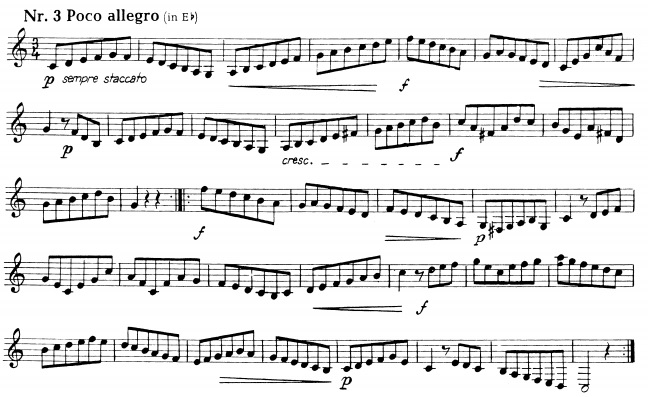Kopprasch #3 is one of the most popular etudes from Kopprasch’s 60 Etudes for Low Horn. It’s not only used by teachers the world over, it is very commonly used in all sorts of audition situations.
Music:
You can purchase the first volume of Kopprasch etudes with this link or you can download a free (but not quite as legible or well done) edition from IMSLP.org. While the free version is great in a pinch, it’s worth spending a little bit of money to own a good hard copy of these etudes – they will likely be used all throughout your horn playing career! Here is the IMSLP.org version of etude #3:
Key Points:
The nice thing about (most) Kopprasch is that the challenges that each etude presents are often quite straightforward. In the case of #3, this one tests the following:
- Articulation – All the notes are tongued and the tempo is moderately quick
- Scales/Arpeggios – Mainly C and G major, although some others are touched on
- Range – This covers the “typical” Kopprasch range, from an A5 down to a C3. This was the expected range of a low horn player when Kopprasch was writing.
- Dynamics – In this particular etude, the dynamics are relatively straightforward. Most of the time, louder = higher.
Technical Tips:
Tonguing in this exercise is crucial! If you haven’t, read my short blurb about articulation, and practice this etude slowly to get a strong “Ta” articulation. In the beginning, don’t worry so much about the sempre staccato – practice the notes full value (but tongued) to make sure that the air speed is responsible for the pitch changes. Practicing small sections on just the mouthpiece (or even just blowing the different air speeds without the mouthpiece or buzzing) can help you refine this technique. Practice “tonguing” staccato notes while just blowing air (like blowing out candles) and see how you can change the length of the notes without consciously stopping your air between the notes.
Know your scales! If you have to read every note of the first 10 or so bars, you don’t know your C major scale well enough.
Know your limits! If you can’t play down to the low C, or up to the high A, then skip those sections in the beginning. Make sure you have a good foundation on the first couple of lines before you spend time with the more extreme registers. Don’t be surprised if the last 2 bars are the most difficult of the piece, especially if you don’t regularly spend time working on articulation in the low register.
Use a metronome! It’s pretty easy to play the first bar or two quickly, but in order to make sure you can play the entire piece at a consistent tempo, make sure to use a metronome at least 80% of the time! Also, record your metronome marks from day to day – this will let you see your progress and (hopefully) provide encouragement!


